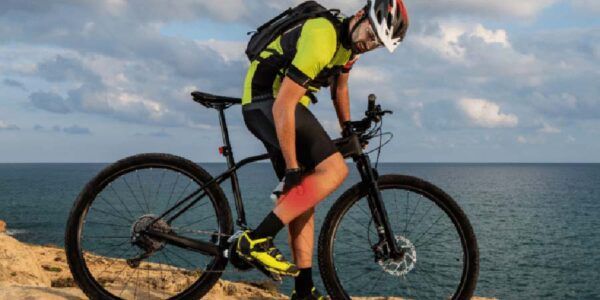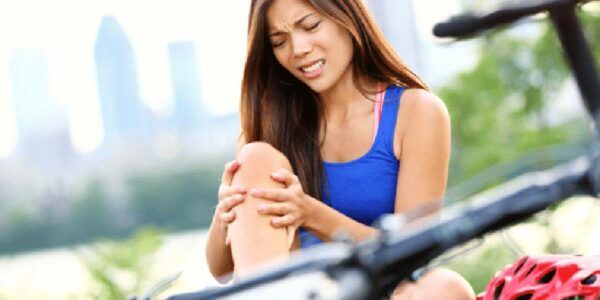What is common cycling injuries?
With many people choosing to exercise outdoors more and more, there are several that have turned to cycling as their way to get back into shape or stay physically active. From the earliest sign of spring to the first big snowfall, the cycling season can last for several months and is therefore very convenient and practical outdoor activity. Cycling is also a fun activity and comes with a sense of adventure and exploration. Plus, it’s a great and low-impact way to stay fit.
But whether you’re a recreational or experienced cyclist, injuries from cycling are common and are most often caused by overuse and by repetitive movements.

We will discuss the most common types of injuries that you should be aware of when cycling and how you can prevent them.
Overuse injuries
Strained muscles may cause you to over-compensate, resulting in overuse injuries. The temptation is to get back on the bike as soon as possible however rest may be necessary to reduce inflammation and pain. Checking in with your physiotherapist at this point can help guide you before you get back on your bicycle.
Lower back pain
One of the most common injuries cyclists suffer with is lower back pain. And often irritated lower back muscles will lead to changes in posture which can impact other parts of the body.
In particular, the erector spinae, the long muscles that run vertically down the spine, that help keep the spine straight are overfatigued from the forward bent position on the bicycle.
If you have lower back pain, here is what you can do:
- Check the position on the bike: If your position is very aggressive with a long stem/top tube and low handlebars, consider raising the handlebars to keep the back straighter and alleviate pressure off your lower back.
- Core strength: If your core muscles are not strong enough, your lower back will collapse on the bike, causing undue strain. Strengthening your core muscles with the help of your physical therapist will also make you a more powerful rider and prevent any back pain/injuries.
Knee pain
Because the knee is constantly bending and straightening while cycling, many cyclists develop knee pain. A patello-femoral syndrome is characterized by a pain or a deep ache around the kneecap and the knee can feel stiff at first when getting up from sitting. The ITB syndrome describes pain focused on the lateral aspect of the knee or kneecap, often accompanied with a feeling of tightness in the hip on the same side. The pain is worse when bending and straightening the knee repeatedly.
Patellar tendonitis is noted as pain and tenderness underneath the kneecap and on the tendon below the knee. It can cause soreness pain after riding and can also be painful during the first few minutes of cycling.
If you have knee pain, here is what you can do:
- Check the size of the frame and saddle height you are riding with to ensure your riding position is efficient and to make sure it is optimal for your height so as not to place extra load on one group of muscles, especially the quadriceps (muscles in front of the thigh).
- Make sure you are planning your training appropriately and having enough rest days between rides. Over-training can also be a cause for knee pain.
- Adding some mobility and flexibility exercises and getting into a routine of hip and knee stretches can also help reduce tension over the kneecap and get things moving a better. Make sure you take adequate rest days. A program of stretching and exercises to help strengthen the tendon have shown to be most effective by research, these can be tailored to you by your physical therapist.
Wrist and neck pain
When too much pressure is being transmitted through the upper body, you’ll feel pain at the level of the neck and at the wrists.
Neck pain can occur if the bars are too low, as the rider is forced to hyperextend their neck to look up to see what’s ahead. If you have neck pain, check to ensure that your reach is not too long and that your handlebars are not too low.
Wrist pain can occur when your handlebar position is forcing the wrists at an unnatural angle. Ulnar neuropathy or handlebar palsy is defined as tingling in the fingers due to pressure at the wrist joint on the ulnar nerve which runs between your ring and little fingers. Carpal tunnel syndrome is a compression at the crease of the wrist joint of the median nerve and causes tingling in the thumb, index, middle and ring finger.
If you have wrist pain, here is what you can do:
- Checking the handlebar position and making sure your wrist is not in a hyperextension (bent backwards) or hyperflexion position (bent forwards).
- Cycling gloves have padded areas to help prevent compression of the ulnar and median nerves – so if you’re struggling, a quality pair of gloves would be very helpful.
If these symptoms however persist and the numbness continues, it is a good idea to see a doctor or your physical therapist.
Ankle pain
While pains in the ankle and foot are less common in cycling, they are usually the result of the repetitive movement of pedaling in an improper manner. Pain at the back of the heel where the Achilles tendon attaches is known as Achilles tendonitis. The cause of this inflammation is a rapid increase in the amount and intensity of training. The tendon becomes irritated from the lack of adequate rest times between rides and may indicate a need to strengthen the calf muscles.
If you have pain at the ankle, here is what you can do:
- Check your bike set-up and your pedaling techniques: are the pedal cleats set up too forward and is the saddle too high? Is the ankle held in a pointed (‘plantar flexed’) position while pedaling, which can irritate the Achilles tendon?
Getting back on the bike with the help of a physiotherapist!
If you have any pain because of cycling, it’s always advisable to get it checked out by a physical therapist as soon as possible. Many bike-related injuries can be resolved quickly and with minimal intervention, but if they are left for too long, they may require more intensive treatment or even surgery.
Our physical therapists will give you a correct diagnosis. Resolving the issue could be as simple as altering your bike setup to reduce the strain on certain parts of your body. Or, you may have a condition requires your physiotherapist to prescribe a personalized plan of care. Either way, the physiotherapist will be able to guide you accordingly and ensure that you get back on the road on your bicycle!





